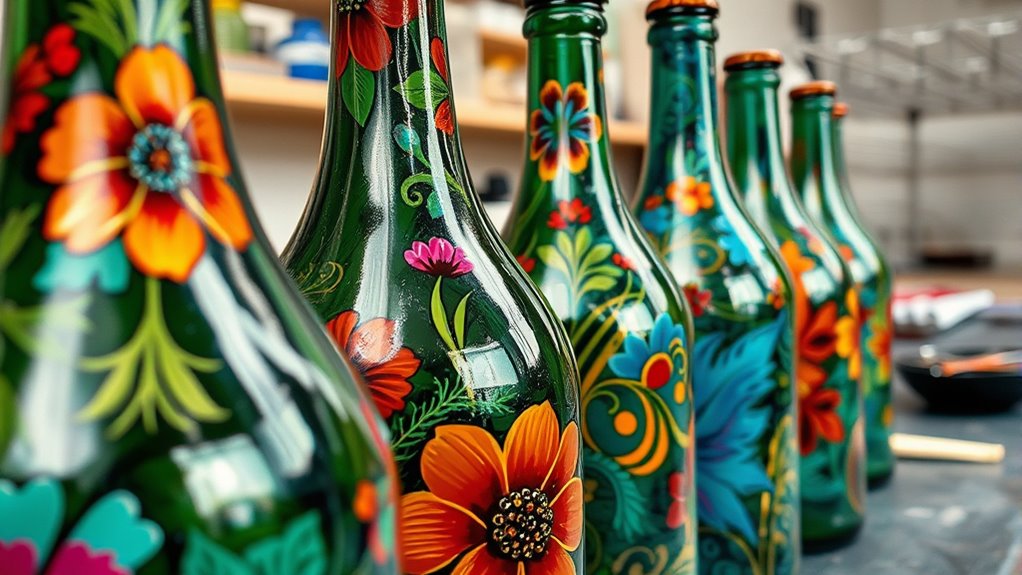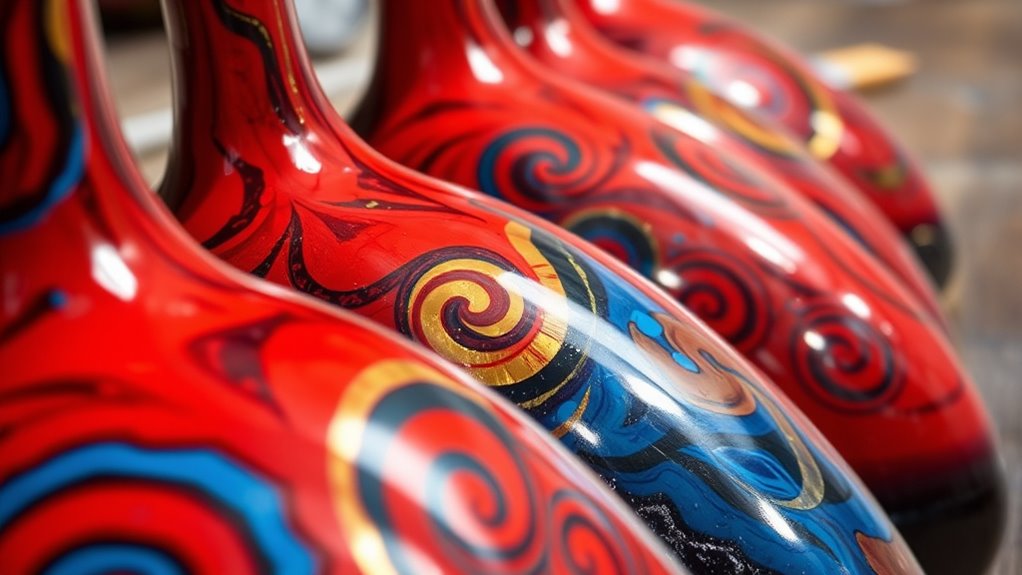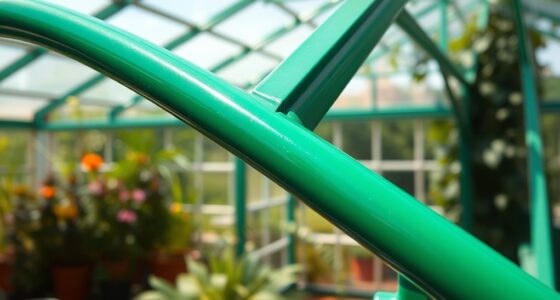When sealing painted bottles with varnishes, apply thin, even coats using smooth brush strokes and follow the manufacturer’s instructions carefully. Maintain a clean, dust-free environment with controlled temperature and humidity—around 70°F and low humidity works best—while avoiding direct sunlight. Let each coat dry as recommended, usually 1-2 hours, before adding another. For full curing, allow at least 24 hours in ideal conditions to guarantee durability. Continuing will show you how these tips improve your finish.
Key Takeaways
- Use thin, even coats of varnish with smooth brush strokes to ensure uniform coverage.
- Follow the manufacturer’s recommended cure time, typically at least 24 hours, before handling or additional coats.
- Maintain a controlled, dust-free environment with proper temperature and humidity during application and curing.
- Avoid direct sunlight and drafts to prevent finish imperfections and uneven drying.
- Patience and proper technique result in a durable, glossy finish that enhances painted bottles’ longevity.

Have you ever painted bottles and wondered how to safeguard your artwork? Choosing the right sealing method is essential to protect your designs and make sure they last. When it comes to sealing painted bottles, your first step is understanding how brush techniques can influence the application of varnishes or sealants. Using smooth, even brush strokes helps prevent streaks and uneven textures, which can compromise the finish. Pay attention to your brush techniques by applying light coats and maintaining a steady hand. This approach ensures the sealant adheres uniformly across the surface, avoiding bubbles or drips that could mar your artwork. Additionally, consider the importance of your drying environment during this process. A clean, dust-free space with controlled temperature and humidity creates the ideal drying environment. Excess humidity can cause the varnish to dry slowly, leading to a tacky surface that’s prone to dust settling or smudging. Conversely, a too-dry environment might cause the sealant to crack or peel. Keep your workspace well-ventilated but free from drafts, which can disturb the drying process. If you’re working indoors, aim for a room with steady temperature, around 70°F (21°C), and low humidity levels. This controlled environment helps the sealant cure evenly and prevents issues like bubbling or cloudiness. It’s also wise to avoid direct sunlight during drying, as UV rays can alter the finish or cause uneven curing. When applying varnishes or sealants, follow the manufacturer’s instructions carefully, paying close attention to recommended drying times between coats. Multiple thin coats usually produce a better, more durable finish than a single thick layer. This process allows each layer to dry thoroughly, reducing the risk of tackiness or imperfections. Remember, patience is key—rushing the drying process can lead to smudges, fingerprints, or compromised adhesion. After applying your sealant, allow ample curing time in your controlled environment, often 24 hours or more, depending on the product. This ensures the sealant hardens fully, providing a durable protective finish for your painted bottles. Proper application techniques combined with a suitable drying environment are crucial to achieving a professional and long-lasting result. Taking these steps not only prolongs the life of your painted bottles but also enhances their appearance, making your creative efforts stand out. So next time you finish painting, remember that the way you apply your sealant and the environment in which it dries are just as important as your original design.
Frequently Asked Questions
Can I Use Household Gloss Varnish for Sealing Painted Bottles?
Yes, you can use household gloss varnish for sealing bottles, but make sure it’s suitable for your project. Household varnish can provide a shiny, protective coating, helping to seal your painted bottles effectively. However, check the label to confirm it’s waterproof and safe for your intended use, especially if the bottles will hold liquids. Apply thin, even coats and let each layer cure thoroughly for the best result.
How Do Temperature and Humidity Affect Curing Times?
Temperature fluctuations and humidity levels profoundly impact curing times. When it’s too hot or humid, varnishes take longer to cure because moisture slows down the process. Conversely, cooler, dry conditions speed up curing but can cause uneven drying or cracks. You should aim for a stable environment with moderate temperature and humidity to guarantee your painted bottles cure properly and achieve a smooth, durable finish.
Are There Eco-Friendly Sealing Options Available?
Think of eco-friendly sealing options as a gust of fresh air for your project. You can choose biodegradable coatings and plant-based sealants that are gentle on the environment but still protect your painted bottles. These options are like a natural shield, offering durability without harmful chemicals. By opting for eco-friendly sealants, you’re making a conscious choice to reduce your ecological footprint while ensuring your bottles stay beautifully sealed and protected.
What Is the Best Way to Remove Dried Varnish Mistakes?
To fix dried varnish mistakes, start with gentle Varnish removal using fine-grade sandpaper or a citrus-based stripper, being careful not to damage the paint. For mistake correction, lightly sand the affected area and reapply varnish smoothly. If needed, use a soft cloth dampened with mineral spirits for spot cleaning. Patience and gentle techniques guarantee you preserve the painted surface while effectively correcting the varnish errors.
Can Sealing With Varnish Alter the Bottle’s Appearance?
Sealing with varnish can definitely change the bottle’s appearance, adding a glossy, gleaming finish that enhances colors and details. This gloss finish gives your bottle a polished, professional look, but it might also subtly alter the original look by deepening hues or smoothing textures. So, if you want to preserve the original appearance, consider testing a small area first, as varnish can sometimes add a shiny sheen or slightly alter the visual vibe.
Conclusion
Sealing your painted bottles with the right varnish and allowing proper cure time guarantees your artwork stays vibrant and protected. While some believe quick-drying varnishes are just as good, evidence shows that patience with slow-curing options leads to a more durable finish. Trust the process—giving your bottles enough time to cure isn’t just a myth but a proven way to preserve their beauty. So, take your time and enjoy the rewarding results.
Cindy thoroughly researches juicing trends, techniques, and recipes to provide readers with practical advice and inspiration. Her writing style is accessible, engaging, and designed to make complex concepts easy to understand. Cindy’s dedication to promoting the advantages of juicing shines through her work, empowering readers to make positive changes in their lives through the simple act of juicing.











